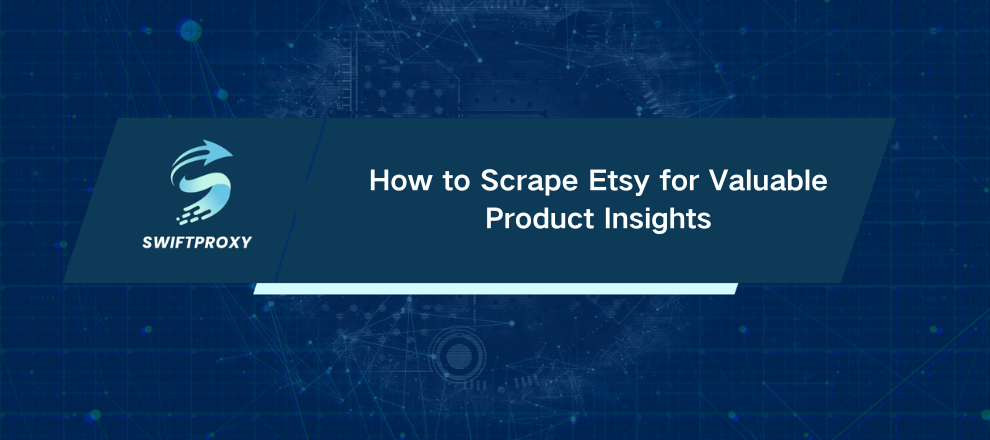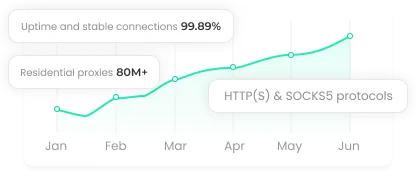How to Scrape Etsy for Valuable Product Insights
Etsy is a marketplace full of opportunity. Millions of unique, handmade, and vintage products are listed by independent sellers every day. Imagine having access to every price, review, and trend snapshot. That’s exactly what web scraping can do for you. Competitive insights, pricing strategies, and trend forecasting are just a click away. Scraping Etsy might sound technical, but it’s a skill any e-commerce professional, analyst, or ambitious seller can master. With the right approach, you can turn raw product data into actionable insights that give you a serious edge in the market. In this guide, we’ll show you exactly how to scrape Etsy—from setting up your environment to leveraging Swiftproxy for secure, uninterrupted scraping. No fluff. No jargon. Just practical, usable steps.

What Is Web Scraping and How It Functions
Web scraping is simply the process of automatically extracting data from websites. Instead of copying and pasting thousands of entries by hand, you let scripts or tools do the heavy lifting. For a sprawling platform like Etsy, which hosts millions of products across countless categories, scraping is the only realistic way to gather actionable data efficiently.
On Etsy, the data you can extract includes:
Product Names: The exact titles of listings.
Pricing Information: Prices, discounts, and offers.
Customer Reviews: Ratings and written feedback.
Seller Information: Ratings, locations, and other products.
Product Descriptions and Tags: Keywords and descriptions that drive search visibility.
With this information, you can uncover trends, analyze competitor strategies, and optimize your own pricing. However, Etsy actively monitors for scraping, and hitting their servers too aggressively can get you blocked. That's why using a high-quality proxy service like Swiftproxy is important.
Tools You'll Need for Scraping Etsy
To scrape Etsy efficiently, you need the right combination of tools and infrastructure:
1. Scraping Software or Scripts
Your choice of scraping tool depends on your technical expertise:
Beautiful Soup (Python-based): Lightweight, ideal for beginners. Pulls data efficiently using Python.
Scrapy (Python framework): Robust and scalable. Handles large volumes of data with ease.
Octoparse (Visual tool): No-code solution. Point-and-click to scrape websites—perfect for smaller projects.
ParseHub (Advanced visual tool): Offers greater flexibility and advanced options for semi-technical users.
Each tool has strengths. Pick based on your comfort with coding and project size.
2. Proxy Service
Multiple requests from the same IP? Etsy will notice—and throttle or block you. Swiftproxy solves this with rotating IPs, high-speed connections, and global coverage. By rotating IP addresses, it keeps your scraping activity anonymous and uninterrupted.
How to Scrape Etsy Safely
Step 1: Configure Your Scraping Environment
Before scraping, prepare your environment:
Install your scraping tool: Beginners can start with Octoparse or ParseHub. Experienced coders might opt for Beautiful Soup or Scrapy.
Sign up for Swiftproxy: Rotating IPs prevent detection and speed up data retrieval. Choose servers near Etsy for optimal performance.
Install dependencies: If using Python-based tools, ensure libraries like requests, BeautifulSoup, or Scrapy are installed.
Step 2: Choose the Data You Need
Focus matters. Etsy is vast, and pulling only the most relevant data saves time and resources. Consider:
Product Names and Descriptions
Prices, Discounts, and Offers
Seller Information (Name, Ratings, Location)
Reviews and Ratings
Tags and Categories
Define your targets before scraping. This makes your workflow efficient and your results precise.
Step 3: Build Your Scraping Script or Configure Your Tool
Code-based tools: Write a script to extract your target data. For example, Beautiful Soup can pull product names, prices, and seller info from listing pages.
Visual tools: Simply click on the elements you want to scrape. Octoparse and ParseHub let you map data visually without writing a single line of code.
Step 4: Handle Pagination
Etsy listings span multiple pages. Your scraper must handle pagination to collect comprehensive data. Both coding and visual tools support automated pagination. Scrape the first page, the second, the third…all the way through to the last product in your target category.
Step 5: Save Your Data
Once scraped, structure your data for easy analysis:
CSV Files: Ideal for small-scale projects. Quick and easy.
Databases (MySQL, MongoDB): Handle large datasets and support complex queries.
Excel: Useful for manual review or small-scale analysis.
Step 6: Track Scraping Activity
Scraping isn't a set-it-and-forget-it task. Monitor activity to avoid overwhelming Etsy's servers:
Use Swiftproxy to rotate IPs and avoid detection.
Implement delays between requests to mimic human browsing.
Scrape in small batches rather than one massive request stream.
Ethical Considerations
Scraping comes with responsibilities:
Follow Etsy's Terms of Service: Avoid violations, especially for commercial purposes.
Don't Overload Servers: Use delays and batch scraping.
Avoid Personal Data: Only scrape public, non-personal information.
How Swiftproxy Makes Etsy Scraping Simple
Swiftproxy offers several advantages:
Rotating IPs: Over 80 million real home IPs across 195+ regions.
High-Speed Connections: High-performance servers ensure fast, reliable scraping.
Security and Privacy: Masked IPs and encrypted connections keep your activity private.
With Swiftproxy, you focus on insights—not troubleshooting blocked IPs or slow connections.
Conclusion
Scraping Etsy isn't just a technical exercise—it's a strategic advantage. With the right tools, proxies, and ethical practices, you can access valuable product data, uncover trends, and make smarter business decisions.
Follow these steps, leverage Swiftproxy, and you'll have the data you need to optimize your e-commerce strategy, outperform competitors, and forecast trends with confidence.

















































